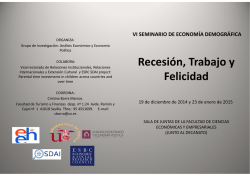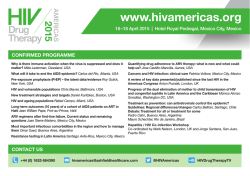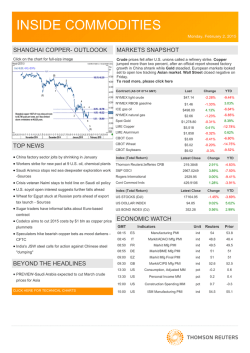
Nutritional composition Pithecellobium dulce, guamuchil aril
Pakistan Journal of Nutrition 14 (9): 611-613, 2015 ISSN 1680-5194 © Asian Network for Scientific Information, 2015 Nutritional Composition of Pithecellobium dulce, Guamuchil Aril Alan Chaparro-Santiago1, Helia R. Osuna-Fernandez2, Josefa Aguillon-Arenas3 and Aida M. Osuna-Fernandez1 1 Departamento El Hombre y su Ambiente, Laboratorio de Biologia Vegetal, Universidad Autonoma Metropolitana-Xochimilco, Mexico, D.F 2 Departamento de Ecologia y Recursos Naturales, Laboratorio de Estructura y Fisiologia de Plantas, Universidad Nacional Autonoma de Mexico. Av. Universidad 3000, Col. Universidad Nacional Autonoma de Mexico, C.P. 04510. Mexico, D.F 3 Laboratorio de Bromatologia, Tronco Divisional CBS, Universidad Autonoma Metropolitana-Xochimilco, Mexico, D.F Abstract: Determining the nutrient content of easily accessible food can allow us to maximize its use in rural populations. Phitecellobium dulce is abundant in large rural areas of southeast Mexico. Using proximate analyses, we find that the aril of P. dulce contains low moisture content (17.167%) compared to the dry matter (82.832%), as well as high content in carbohydrates (69.092%), which is the major nutritional component. Proteins represent a 9.33% and crude fat, ash and crude fiber percentages were in the range of 1.1 and 1.6%. Significant differences were found in the carbohydrates content when compared on dry basis to on wet basis, although in both cases the same tendency to high values was observed. For crude protein, values were significantly higher on dry basis compared to wet basis and for crude fat content, ash and crude fiber not significant differences were found. We recommend processing and consumption of aril in dry basis for a more efficient use of this food. These results suggest that P. dulce aril could be utilized as a nutritious and affordable food alternative in rural areas. Key words: Pithecellobium dulce, bromatology, food properties, food alternative pods, measuring up to 20 cm long and 10 to 15 mm wide, with constrictions between seeds, short hairs and white and fleshy arils covering the seeds. In general, each pod contains 5 to 10 shiny black bean-shaped seeds, each one measuring around 1 cm long (Parrotta, 1991). There are documents that report harvesting and consumption practices by the Mixtecs in Guerrero’s mountains, indicating that they benefit from the consumption of the aril and the seed and the usage of different parts of the tree (Casas and Caballero, 1995). Aril is fleshy and sweet, originates from the raphe, funiculus, hilum or from the chalaza and covers the seed partially or completely (Gonzalez et al., 2007). Attraction of animals for seed dispersal is one of its ecological benefits and human consumption is among its nutritional and economic benefits (Olivares-Perez et al., 2011). There is the knowledge for identification of fruit with different flavors for consumption; in some regions of Mexico, for example, in Guerrero’s mountains, there are sweet and bitter fruits and only the sweet fruit is harvested for consumption (Casas and Caballero, 1995). Nutritional analysis of the seeds aril allow the INTRODUCTION Guamuchil, Pithecellobium dulce (Roxb.) Benth., considered a resource with multiple uses (Monroy and Colin, 2004), is a medium size fast growing evergreen tree that belongs to the Fabaceae family, subfamily Memosoideae, native to the American tropics. Generally it is distributed in semi-arid regions of dry deciduous forest. It has been successfully planted in areas with a 4-5 months dry season; thus, it is considered a heat and drought resistance species (Parrotta, 1991). Guamuchil uses are varied; among them, it can be mentioned timber-yielding, fertilizer, forage, shade, medicinal, live fence and edible (Parrotta, 1991; Zamora et al., 2001; Monroy and Colin, 2004; Berdonces, 2010; Pinto-Ruiz et al., 2010) as well as the usage of its extracts as insecticide (Perez-Pacheco et al., 2004), fungicide (Bautista-Banos et al., 2003), antioxidant and α amylase and α -glucosidase inhibitor (Pio-Leon et al., 2013). The tree produces fruit that mature 3 to 4 months after bloom. Fruit are linear, curve or rolled up dehiscent Corresponding Author: Helia R. Osuna-Fernandez, Departamento de Ecología y Recursos Naturales, Laboratorio de Estructura y Fisiologia de Plantas, Universidad Nacional Autonoma de Mexico. Av. Universidad 3000, Col. Universidad Nacional Autonoma de Mexico, C.P. 04510. Mexico, D.F 611 Pak. J. Nutr., 14 (9): 611-613, 2015 Table 1: Nutritional content percentage in wet and dry basis of P. dulce -------------- Wet basis -------------Content (%) S.D. Moisture 17.1678 0 Dry matter 82.8321 0 Crude protein 9.3315 0.342 Crude fat 1.6538 1.437 Ash 1.1044 0.478 Crude fiber 1.6384 0.358 Carbohydrates 69.0926 1.580 S.D: Standard deviation population to know the properties of a seasonal alternative food. This information can be used as an advantage to promote the beneficial effects for consumer’s health which gain importance in regions with high degree of marginalization, as it is case for the region studied (Sedesol, 2013). Therefore the objective of this research was to know the nutritional properties of Guamuchil aril of the seed using proximate analyses. Crude protein Crude fat Ash Crude fiber Carbohydrates --------------- Dry basis --------------Content (%) S.D. 11.2656 0.413 1.9966 1.734 1.3333 0.577 1.9914 0.453 83.4129 1.908 basis compared to wet basis analysis (t = -6.25; p = 0.003) and no significant differences were detected for crude fat, ash and crude fiber (t = -0.26; p = 0.80; t = -0.53; p = 0.62; t = -1.05; p = 0.35, respectively). DISCUSSION Regarding crude fiber content, values were lower than previous reports (5.83-6.12%) (Pio-Leon et al., 2013). These differences might be due to the environmental conditions of the harvesting site, Pio-Leon et al. (2013) worked with material collected in Culiacan, Sinaloa, while fruit collected in Tepecuacuilco de Trujano, Guerrero, was used for the analysis of the present study. As already mentioned by these authors, geographical and environmental factors may affect composition and biological activity of P. dulce fruit. The carbohydrates content in P. dulce is higher than in other legumes species like Leucaena esculenta (red guaje), Leucaena leucocephala (green guaje) and Tamarindus indica (38-68%), which had higher carbohydrates levels than soybean, pea, broad bean and red kidney bean (Bhat and Karim, 2009; RomanCortes et al., 2014). It has been reported that P. dulce aril has a high content of vitamin C (79.7-82.2 mg 100/g fresh weight), pectins (9.4% on dry basis and 2% in fresh basis), phenolic compounds (from 27 to 60%) and organic acids (15%) (1.8). Based on the results obtained in the present study, aril consumption might represent an alternative food resource for marginalized regions such as Tepecoacuilco de Trujano, Guerrero, since its high carbohydrates content represent a rapid source of immediate energy. On the other hand, the high content of vitamin C can provide diverse health benefits to the consumer, its antioxidant effect is only one of them (Traber and Stevens, 2011). It should be pointed out that protein content and carbohydrates was higher on dry basis than in fresh tissue which may suggest a possibility for drying the fruit for consumption. This, besides allowing a different kind of consumption of the product for the population, might represent an incentive for promoting products elaboration that could support the economy of the inhabitants of the locality. MATERIALS AND METHODS Biological material: Seeds were harvested in Tepecoacuilco de Trujano, municipality located in San Juan Tetelcingo, Guerrero, Mexico. Seeds were transported in paper bags to the laboratory and the specimen for the herbarium was prepared with the reference number IMSSM 15729. Laboratory tests: In the laboratory, aril was separated from the seeds and dried at room temperature for 30 days. The following determinations were carried out using the dry material: (a) dry and wet matter, (b) total ash and organic matter, © ether extract or crude fat (AOAC, 1975), total nitrogen (macro-Kjeldhal method) and crude protein, (e) crude fiber (Weende method with modifications) and (f) nitrogen free ether extract (carbohydrates) (Weende method). The values obtained were analyzed using t-test for independent samples. RESULTS Bromatological analysis show a low moisture percentage (17.167%) compared to the dry matter (82.832%). Nutritional determinations revealed that P. dulce aril have high content of carbohydrates in both wet and dry basis (69.092 and 83.4%, respectively) standing out as the major nutritional component (Table 1). Proteins also represent an important aril component with a 9.331% on wet basis and 11.3 on dry basis. Crude fat, ash and crude fiber contents show percentages in the range 1.1 and 1.6% on wet basis and 1.3 and 1.99 on dry basis. Regarding the carbohydrates content, significant differences were found between dry basis and wet basis analysis (Table 1) (t = -10.01; p = 0.0006), although in both cases high values were observed. With respect to crude protein, values were significantly higher on dry 612 Pak. J. Nutr., 14 (9): 611-613, 2015 Conclusion: Bromatological analysis of P. dulce show that its consumption may represent a favorable food alternative for the inhabitants of the community of San Juan Tetelcingo, Guerrero, since it has a high content of proteins and carbohydrates and therefore, it can complement their diet and provide health benefits to a Mexican marginalized community. Based on the results obtained in the present study, it would be important to promote elaboration of a food product from P. dulce that were accessible to the population. Parrotta, J., 1991. Pithecellobium dulce (Roxb.) Benth. Guamúchil, Madras thorn. SO-ITF-SM-4, New Orleans, LA: U.S. Department of Agriculture, Forest Service, Southern Forest Experiment Station, pp: 5. Perez-Pacheco, R., C. Rodriguez-Hernandez, Lara-J. Reyna, R. Montes-Belmont and G. RamirezValverde, 2004. Toxicidad de aceites, esenciales y extractos vegetales en larvas de mosquito Culex Quinquefasciatus Say (Diptera: Culcidae). Acta Zool. Mex., 20: 141-152. Pinto-Ruiz, R., D. Hernandez, H. Gomez, M. Cobos, R. Quiroga and D. Pezo, 2010. Arboles forrajeros de tres regiones ganaderas de Chiapas, Mexico: Usos y caracteristicas nutricionales. Universidad y Ciencia, 26: 19-31. Pio-Leon, J., S. Diaz-Camacho, J. Montes-Avila, G. Lopez-Angulo and F. Delgado-Vargas, 2013. Nutritional and nutraceutical characteristics of white and red Pithecellobium dulce (Roxb.) Benth fruits. Fruits, 68: 397-408. Roman-Cortes, N., M. Garcia-Mateos, A. CastilloGonzalez, J. Sahagun-Castellanos and A. JimenezArellanes, 2014. Componentes nutricionales y antioxidantes de dos especies de Guaje (Leucanena spp): un recurso ancestral subutilizado. Rev. Chapingo, Ser. Hortic., 20: 157170. Sedesol, 2013. Catálogo de comunidades. Retrieved from: Secretaria de Desarrollo Social <http://cat. microrregiones.gob.mx/>. Traber, M. and J. Stevens, 2011. Vitamins C and E: Benefical effects from a mechanistic perspective. Free Radical Biol. and Med., 51: 1000-1013. Zamora, S., J. Garcia, G. Bonilla, H. Aguilar, C. Harvey and M. Ibrahim, 2001. Uso de frutos y follaje arboreo en la alimentacion de vacunos en la epoca seca en Boaco, Nicaragua. Agrofor Am., 8: 31-38. REFERENCES AOAC, 1975. Official Methods of Analysis, 12th. Washington, DC: Association of Official Analytical Chemists USA. Bautista-Banos, S., E. Garcia-Dominguez, L. BarreraNecha, R. Reyes-Chilpa and C. Wilson, 2003. Seasonal evaluation of the postharvest fungicidal activity of powders and extracts of huamúchil (Phitecellobium dulce): action against Botrytris cinerea, Penicillium digitatum and Rhizopus stolonifer of strawberry fruit. Postharvest Biol. Technol., 29: 81-92. Berdonces, J., 2010. Gran Enciclopedia de las Plantas Medicinales. Espana: Oceano. Bhat, R. and A. Karim, 2009. Exploring the nutritional potential of wild and underutilized legumes. Comp. Rev. Food Sci. Food Saf., 8: 305-331. Casas, A. and J. Caballero, 1995. Domesticacion de plantas y origen de la agricultura en Mesoamerica. Ciencias, 40: 36-44. Gonzalez, A., E. Cedillo and L. Diaz, 2007. Morfologia y Anatomia de las Plantas con Flores. Mexico: Universidad Autonoma de Chapingo. Monroy, R. and H. Colin, 2004. El guamuchil Pithecellobium dulce (Roxb.) Benth, un ejemplo de uso multiple. Madera y Bosques, 10: 35-53. Olivares-Perez, J., F. Aviles-Nova, B. Albarran-Portillo, S. Rojas-Hernandez and O. Castelan-Ortega, 2011. Identificacion, usos y medicion de leguminosas arboreas forrajeras en ranchos ganaderos del sur del estado de Mexico. Trop. Subtrop. Agroecosyst, 14: 739-748. 613
© Copyright 2025



